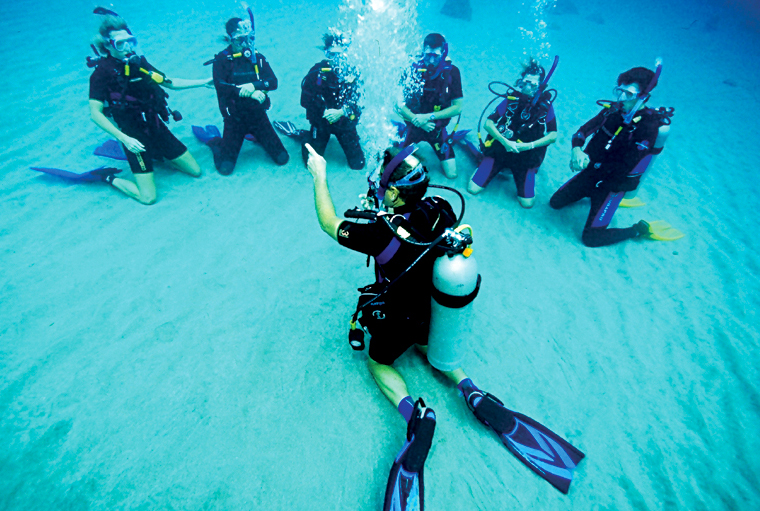There really is no excuse for divers to be on their knees during scuba training except for the very beginning in confined water. We don’t train kneelers, we train divers. And there is a difference.
Early In Training
Different agencies teach slightly different ways. That’s the nature of things. When I was training with PADI back in the day, we spent a lot of time on our knees. Not just in the pool, or in confined water, but in Open Water too. I’ve seen it at every level from Open Water to IDC. Yes, even during Instructor Training. The problem with this is, you start to see divers improperly weighed and it builds a very bad habit.
Let’s be real about this—if you need to adjust the strap of your mask at depth for example, you can’t just go kneel on the bottom of the ocean. What if you’re already 20 meters down and the ocean floor is another 30 meters beyond that? What if you’re above coral or other marine life? It’s utterly illogical to think that you’re going to go kneel to do this skills, so why would you always practice it kneeling. That makes no sense.
So, early on, it’s important to master one’s buoyancy and to practice all skills from diver position.
Perfect Practice Makes Perfect
This is a mantra of mine. Trust me. My students all have heard me say this a million times; garbage in, garbage out. Good in, good out. You have to practice correctly in the beginning to ensure you do not develop training scars. Crappy practice will produce crappy results—every time.
When Is Kneeling on the Sand Okay?
The only time it’s okay to kneel on the ocean floor is never. I mean it. Really, there’s never a logical time to do it. I accept that sometimes during training (yes, I admit I’ve done it too) it makes things easier. But that doesn’t mean it’s right. You may not realize it, but there’s little creatures that live in that sand, even if you don’t see them. They’re there. Hoping to not get wiped out. A lot of them.
I tell my instructor candidates to really only kneel in Confined Water training in a pool or an area that has obviously been destroyed already. In Cozumel, for example, we have a little cove we train in where divers have been walking around, kneeling, and bumping against the ground there for decades. It’s dead. It might as well be a concrete floor. In that respect, it’s okay I think. Probably not a major deal.
Standards Aren’t The Standard
What does your agency say in their published Standards about kneeling on the ocean floor? And does it matter?
I have all of PADI’s material from Open Water up to Course Director. As an SSI Instructor Trainer (same level as Course Director) I have all of SSI’s material too. Obviously. But I also have copies of NAUI’s, TDI’s, PDIC’s and many other agency ‘s Standards in my collection. All of these organizations require new students to master skills before they go into the Open Water. For me, that includes buoyancy. Why wouldn’t it?
But in practice, that’s not what I see. Get in the water with instructors from different organizations and it will be ridiculously clear which agencies push diver position and which do not. For me though, it doesn’t matter what the agency publishes or says. At the end of the day dear diver, you know what is right and what isn’t. I believe in exceeding standards, always. Where possible anyway.
That means making sure my students (from Open Water all the way up to the highest Instructor levels) focus on getting up off the bottom and practicing each and every in-water skill possible from neutral buoyancy, with as much control as humanly possible. This expectation makes them better divers. Sure, they’ll mess it up at first. We all do, right? But eventually, they’ll get it. Those who don’t do this, won’t. Simple as that.
Keeping Them Honest
My goal isn’t to, as the Brits say, slag anyone off here. I’m not slamming any diver or agency in particular. All I’m saying is, let’s do what’s right. As a diver, force yourself to really get good at your skills without changing position in the water column. Lead by example, and others will take notice and follow.
